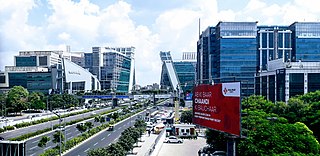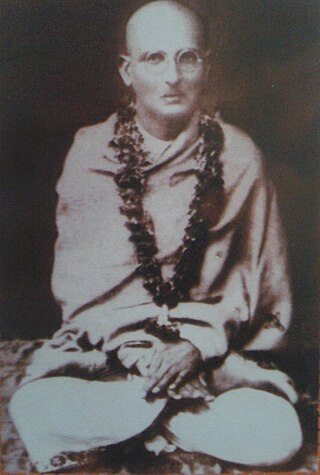
Haryana is an Indian state located in the northern part of the country. It was carved out after the linguistic reorganisation of Punjab on 1 November 1966. It is ranked 21st in terms of area, with less than 1.4% of India's land area. The state capital is Chandigarh, which it shares with the neighbouring state of Punjab; the most populous city is Faridabad, a part of the National Capital Region. The city of Gurgaon is among India's largest financial and technology hubs. Haryana has 6 administrative divisions, 22 districts, 72 sub-divisions, 93 revenue tehsils, 50 sub-tehsils, 140 community development blocks, 154 cities and towns, 7,356 villages, and 6,222 villages panchayats.

Gurgaon, officially named Gurugram, is a satellite city of Delhi and administrative headquarters of Gurgaon district, located in the northern Indian state of Haryana. It is situated near the Delhi–Haryana border, about 30 kilometres (19 mi) southwest of the national capital New Delhi and 268 km (167 mi) south of Chandigarh, the state capital. It is one of the major satellite cities of Delhi and is part of the National Capital Region of India. As of 2011, Gurgaon had a population of 876,969.

Bhiwani district is one of the 22 districts of the northern Indian state of Haryana. Created on 22 December 1972, it was the largest district of the state by area, before the creation of Charkhi Dadri as a separate district, as it occupied an area of 4,778 square kilometres (1,845 sq mi) and administered 442 villages with a population of 1,634,445. Sirsa is now the largest district of the state.

Najafgarh is a town in the South West Delhi district of National Capital Territory of Delhi, India. It is one of the three subdivisions of the Southwest Delhi district. Najafgarh is located on outskirts of NCT Delhi in south western part of Delhi sharing its territory limits with Gurgaon and Bahadurgarh, in Haryana.

Born Shri Beli Ram Ji, Shri Swami Swarupanand Ji Maharaj, was an Indian Guru of Shri Paramhans Advait Mat lineage. He is also known as "Shri Nangli Niwasi Bhagwaan Ji", as "Hari Har Baba", as "Sadhgurudev Ji" and as "Second Guru". Born in the village of Teri in Kohat district, India, he was initiated into the sanyasas in the early 1900s in Teri by Shri Paramhans Swami Advaitanand Ji, who named him Shri Swami Swarupanand Ji. During Swami Advaitanand ji's life, Swami Swarupanand ji created an order of sanyasis in northern India and founded several centers with the purpose of disseminating his master's teachings.

Gurgaon district, officially known as Gurugram district, is one of the 22 districts of Haryana in northern India. The city of Gurgaon is the administrative headquarters of the district. The population is 1,514,432. It is one of the southern districts of Haryana. On its north, it is bounded by the district of Jhajjar and the Union Territory of Delhi. Faridabad district lies to its east. To its south lie the districts of Palwal and Nuh. To the west lies Rewari district.
Mundka is a census town and village in the West Delhi district of Delhi. It is the birthplace and village of former Chief Minister of Delhi, the late Dr. Sahib Singh Verma. Its neighbouring villages are Bakkarwala and Nangloi. The current MLA of the Mundka constituency is Dharampal Lakra, a member of the Aam Aadmi Party (AAP).

Pehowa is a town and a municipal committee in Kurukshetra district in the Indian state of Haryana. It is an important sacred Hindu pilgrimage site, related to Krishna and the Mahabharata, within the 48 Kos Parikrama of Kurukshetra. The Hindu genealogy registers at Peohwa, Haryana are kept there at the Pruthudak Tirath on the banks of Sarasvati river.
Kharkhoda is a city and municipal committee in Sonipat district in the Indian state of Haryana and is a part of National Capital Region (NCR). In Kharkhoda Chhapadeshwar Mahadev Mandir is very popular within the connected villages. At the time of Maha Shivratri festival a large number of tourists comes for visiting the temple. Due to the proximity of UT of Delhi, there is a lot of scope of industrial and residential development in the area. Haryana State Industrial and Infrastructure Development Corporation acquired 3,200 acres of land to develop Industrial Model Township (IMT). Western Peripheral Expressway (KMP) is just 1 km and Delhi–Amritsar–Katra Expressway is 5 km away from the city. On 28 August 2022 Shri Narendra Modi laid foundation stone of Maruti Suzuki's new manufacturing plant in Kharkhoda. Khanda village of Kharkhoda block have a statue of Baba Banda Singh Bahadur which was inaugurated by CM of Haryana Manohar Lal Khattar on Shaurya Diwas celebrated in Khanda, Sonipat.
The Western Peripheral Expressway (WPE) or Kundli–Manesar–Palwal Expressway, is an operational 6-lane, 135.6 km (84.3 mi)-long Expressway in the Haryana state of India. Along with the Eastern Peripheral Expressway, the Western Peripheral Expressway is expected to divert more than 50,000 heavy vehicles away from Delhi, which will help to maintain good air quality in Delhi. Western Peripheral Expressway along with Eastern Peripheral Expressway completes the largest Ring Road around Delhi. There are 10 tolled entries and exits, from north to south - Kundli, Kharkhoda, Bahadurgarh, Badli, Fartukhnagar, Panchgaon, Manesar, Taoru, Sohna & Palwal. Toll rate notified in December 2018 is INR1.35 per km for cars, INR2.18 per km for light motor vehicles, INR4.98 per km for trucks and buses, and two wheelers are not permitted on the expressway.

The Najafgarh drain or Najafgarh nalah, which also acts as Najafgarh drain bird sanctuary, is another name for the northernmost end of River Sahibi, which continues its flow through Delhi, where it is channelized, and then flows into the Yamuna. Within Delhi, due to its channelization for flood control purposes, it is now erroneously called "Najafgarh drain" or "Najafgarh nullah." It gets this name from the once famous and huge Najafgarh Jheel (lake) near the town of Najafgarh in southwest Delhi and within urbanized Delhi. It is the Indian capital's most polluted water body due to direct inflow of untreated sewage from surrounding populated areas. A January 2005 report by the Central Pollution Control Board classifies this drain, with 13 other highly polluted wetlands, under category ‘'D'’ for assessing the water quality of wetlands in wildlife habitats.
Najafgarh Lake, Najafgarh Marsh or Najafgarh Jheel, fed by Sahibi River, used to be a vast lake in the south west of Delhi, near the town of Najafgarh, from which it takes its name. It was connected to the river Yamuna by a natural shallow nullah or drain called the Najafgarh nullah. However, after the 1960s the Flood Control Department of Delhi kept widening the Najafgarh drain. The reason provided by the department was saving Delhi from floods. This widening led to the eventually drainage of, the once huge and ecologically rich, Najafgarh lake. Rainwater accumulating in the Najafgarh lake or jheel basin had been recorded to have occupied more than 300 square kilometres (120 sq mi) in many years before its draining.
Haryana Environment Protection Council (HEPC) is an advisory committee formed in 2006 to advise the Ministry of Environment, Govt. of Haryana on environment issues. It is headquartered at Chandigarh. The committee was scheduled to be reconstituted in year 2011.
Chhawla or Najafgarh drain city forest consists of forestry plantations near the town of Chhawla on both embankments of Najafgarh drain, which is the delhi-end of Sahibi River originating from Aravalli range mountain in Rajasthan, flowing along the border of Haryana state and south west Delhi in India before converging with Yamuna. It provides refuge to local and migratory wildlife specially waterfowl and other water birds. The area is a subset of the entire Najafgarh drain in rural south west Delhi with forested plantations on both its embankments which has been proposed as the Najafgarh drain bird sanctuary.

The Sahibi river, also called the Sabi River, is an ephemeral, rain-fed river flowing through Rajasthan, Haryana and Delhi states in India. It originates in the eastern slopes of the Saiwar Protected Forest (PF) hills in Sikar District, enters Jaipur district near the foot of these hills, and after initially flowing southeast and east turns northeastwards near Shahpura and continues further till it exits Rajasthan to enter Haryana and further drains into Yamuna in Delhi, where its channeled course is also called the Najafgarh drain, which also serves as Najafgarh drain bird sanctuary. It flows for 300 km of which 157 km is in Rajasthan 100 km is in Haryana and 40 km in Delhi.
Blue Bird Lake, Hisar is a resident and endangered migratory bird wetland habitat, lake and recreation area in the town of Hisar, in the Hisar district of Haryana State, India.
Khaira is an Ahir-dominated urban village inhabited by people belonging to Lamba and Aphariya gotra, located on Shaheed Rao Laxmi Chand Marg in Najafgarh tehsil of South West Delhi, Delhi.
Sheetla Mata Temple is a Hindu temple dedicated to the goddess Shitala (Sheetla), wife of Guru Dronacharya who was the teacher of the Pandavas and Kauravas according to an Indian epic Mahabharata. The temple is located on Sheetla Mata Road in old Gurugram city of Gurugram district in the state of Haryana in India.
Khanda is a big and historical village in Kharkhoda tehsil of Sonipat district in Haryana, India. It is located 2 miles (3.2 km) from Kharkhoda and 7 miles (11 km) from Sonipat. It is a part of the Delhi NCR. Khanda has two Gram Panchayats Khanda Khas and Khanda Alman. Two Sarpanchs elects from the village in every five years. Khanda is the head of 12 villages of Dahiya Khap mainly known as.

Shri Swami Keshwanand Satyarthi Ji Maharaj was an Indian guru of Shri Nangli Sahib lineage. The spiritual institution Paramhans Satyarthi Mission was led and governed by him. In 1985, Shri Paramhans Swami Ramanand Satyarthi Ji Maharaj anointed him as his spiritual successor and the patron saint of the Paramhans Satyarthi Mission. Swami Keshwanand Satyarthi Ji Maharaj travelled around the world and preached about spirituality and enlightenment. Swami Ramanand Satyarthi Trust, Shri Satyarthi High School, Shri Satyarthi Sevadal and Shri Satyarthi Sandesh Magazine were also administered under his guidance.









